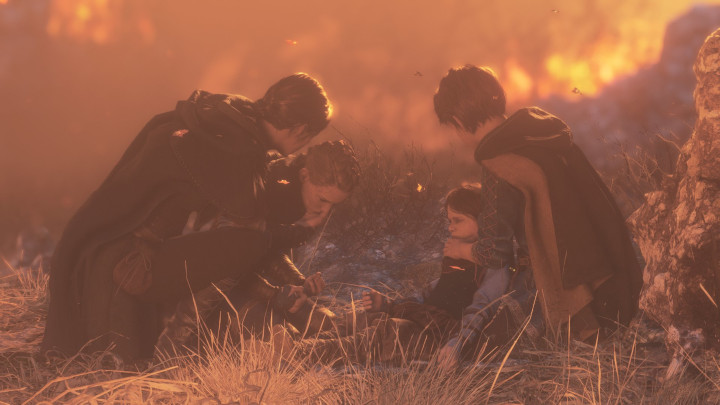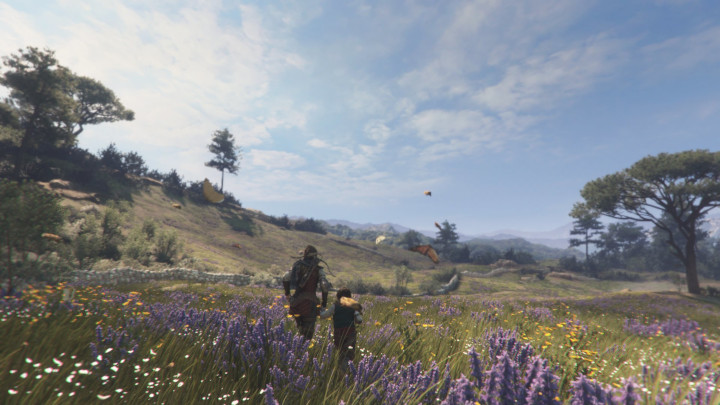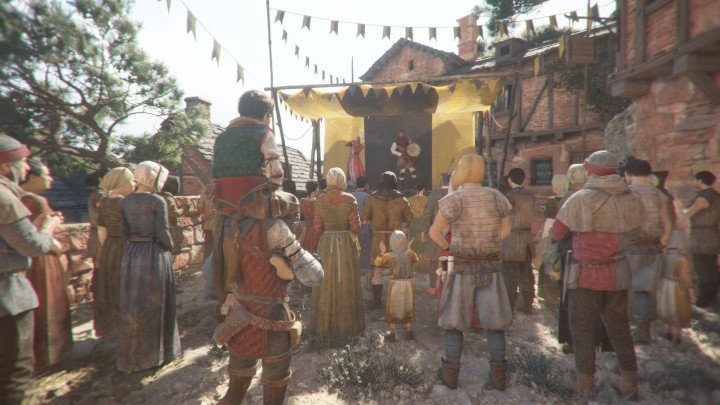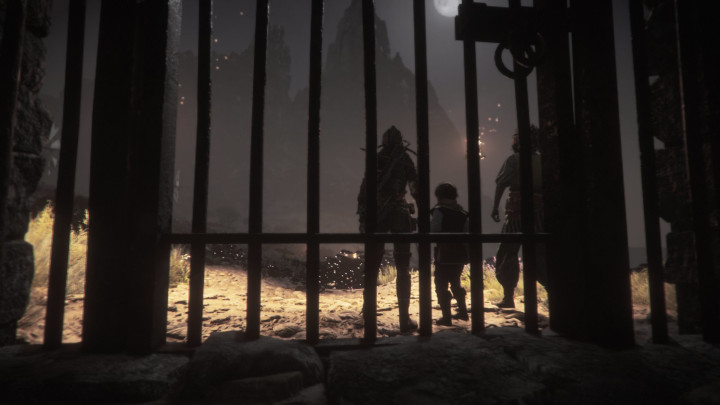
2019’s A Plague Tale: Innocence was a hugely ambitious title that succeeded for its insistence on sticking to the things it did best without trying to bulge or bloat the experience longer than necessary. In an environment of massive, collectible-filled open-world games, Innocence felt like a breath of fresh air. With a runtime of about 14 hours (though some will insist it’s more like 10), the game is just long enough to tell the story it wants to tell without bogging players down in distracting side content.
I think a useful point of comparison would be the stuff Naughty Dog was doing at the end of the PS3 era. Think taut, narrative-focused games with set-piece spectacle (like Uncharted 2 and 3) and gripping, visceral character drama (like The Last of Us). These were games that wore their linearity as a badge of honor rather than as an insult, funneling players through their stories like they were guests on a haunted hayride.
Innocence never feels unsure of its identity, and its narrative focus is razor-thin. This allows the game to build its tension like a vice grip that’s slowly tightening over the course of those 14 hours rather than in disconnected story chunks that players will experience in between hours of paint-by-numbers side activities.

Innocence tells the story of two siblings attempting to survive in a Plague-ridden 14th Century France while being hunted by merciless Inquisitors. The first half almost feels like historical fiction. Of course, it does start to feel super video-gamey in the second half — for instance, Grand Inquisitor Vitalis Bénévent injects himself with diseased blood so he can control rat tornadoes, which sounds more like something you’d see in a Metal Gear game than in a history book. But even when the game is dancing to these absurdities, it never breaks the tension that grips its story from start to finish.
So when I heard that the sequel, A Plague Tale: Requiem, was going to be almost twice as long as the previous game, I was a little bit nervous that developer Asobo Studio was going to be a little too indulgent this time around. After all, with the warm reception of Innocence, Asobo had earned themselves the right to go bigger and bolder for the second chapter in this Medieval story. But a bigger story isn’t necessarily a better one, and Innocence really does feel like the perfect length.
But now that I’ve actually experienced Requiem’s story, I’ve completely dropped my reservations. The game definitely earns its longer runtime with the sheer spectacle of its set-pieces and the bright charm of its more peaceful locales.

Yes, in the first game, we were barely introduced to the lighter side of this game world before it was torn asunder by the Plague. For most of Innocence‘s runtime, we saw a world ravished by the effects of the pandemic, with little trust to be had and horrific results on the game’s major characters. Over and over again, we see protagonist Amicia de Rune sacrifice pieces of her humanity to continue surviving this world. Whether it was feeding a live, jovial pig to a piranha-like swarm of rats or bashing in the face of a soldier with a well-aimed stone, Amicia was forced to commit a lot of acts that I doubt any of us would enjoy having to do. Unless you’re a psychopath, I suppose…
There’s a brief hint of a festival in the post-credits chapter of Innocence, which makes it seem like we might get to enjoy some downtime with our protagonists, but the children are hurried off before they can actually partake in it and then the game ends for real. This was an odd choice for an ending of a standalone game, but in retrospect, it does seem like it’s prepping you for the sequel.
Because A Plague Tale: Requiem is chock full of festivals, of brightly colored locales filled with whimsy, music, and something that was largely absent from Innocence: genuine joy. Yes, the game indulges in these scenes, but that serves to break up the looming dread that hangs over these characters. The Plague still exists, after all, and whatever is wrong with Hugo is still very much affecting him. In fact, Hugo’s rat-summoning disease has only gotten worse, causing tidal waves of rats to pour through villages, destroying everything in their way. It’s also killing him.

So the festivals that endear you to the sheer beauty of the game world are like poison-filled apples. The pleasant sweetness of the apple is there to mask the danger of the poison inside. Requiem balances this dynamic brilliantly, weaving a story that feels simultaneously darker and more beautiful than Innocence.
Some of these brighter scenes are underscored by soft, reverby choral arrangements that have this dreamlike feel to them. These audio cues have this sense of serenity to them while also feeling slightly foreboding. It’s a deliberate siren call that lulls you into letting your guard down before the next tragic event bears down on our protagonists. In the words of Hugo, “Nothing ever stays nice. It always turns bad. Always.”
And these events — where Amicia is again forced into making unenviably weighty decisions — really start taking their toll in Requiem. At one point early in the game, she pretty much snaps, going into a berserker rage that might make even someone like Wolverine feel a little nervous.
The 14th Century seems like a strange time period for an exploration of mental health — especially considering how far we still have to go in this area in the 21st Century — but Requiem absolutely nails it. As someone who struggles with mental illness myself, and has several close acquaintances who have suffered from traumatic brain injuries, Amicia’s possible brain injury does feel pretty genuine. It’s something that never fully prevents her from doing the things she needs to do to survive, but it does cause her to struggle more than she would otherwise, and you can see that manifest the clearest in the moments where she starts acting inconsolably irritable. In fact, I found myself relating to her far more closely in Requiem than I did in Innocence.

Requiem also introduces us to some new characters, and I don’t want to say too much, but some of those folks have genuinely surprising character arcs. Characters you hate might end up endearing themselves to you, while the characters you start growing attached to might ultimately betray you in the cruelest ways possible. Most importantly, though, these characters feel like real people, with actual feelings, opinions, and motivations. And they act in accordance to those feelings, opinions, and motivations rather than as NPCs assigned to specific sections of the game to simply move the plot along. Just prepare to have your heart absolutely wrecked by these characters.
I’ve been hearing really good things about the Plague Tale series ever since Innocence first came out back in 2019, but now that I’ve binged Innocence and Requiem back to back, I can absolutely see why these are becoming cult classics. A Plague Tale: Requiem is a masterpiece of interactive storytelling, one that’s going to sit with me for a long, long time. I played a lot of video games in 2022, and I can say with confidence that this is definitely one of the best things to come out this entire year.